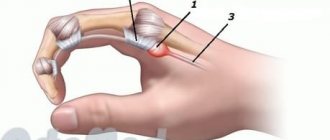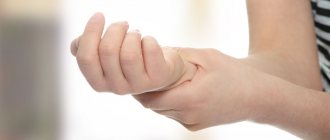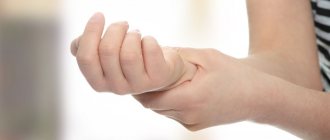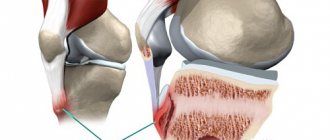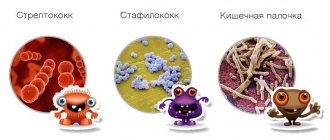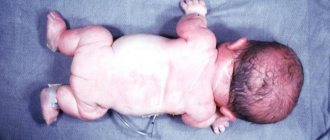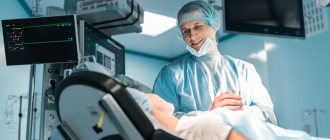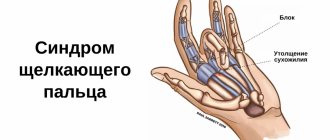Symptoms of de Quervain's tenosynovitis
Typically, de Quervain's tenosynovitis begins gradually and develops slowly. Therefore, it often takes many days, and sometimes weeks, before the patient sees a doctor.
But in about 10% of cases the disease develops quickly. This usually happens if de Quervain's disease was triggered by an injury, a blow to the arm, or a fall on the arm. In such situations, patients often consult a doctor immediately after an injury, and they are usually treated for a long time for a bruise, without noticing that the bruise has long turned into another disease (i.e., de Quervain’s tenosynovitis).
The main symptom of de Quervain's tenosynovitis is pain at the base of the thumb and under it, along the edge of the wrist joint. But sometimes the pain radiates to the tip of the thumb or spreads up the arm to the elbow or even to the shoulder (but this happens extremely rarely).
Irradiation of pain to the elbow or shoulder can lead to diagnostic errors. There are situations when such patients are treated for “cervical osteochondrosis with a shot in the arm,” or for “neuralgia of the brachial plexus,” or something similar.
In such situations, a detailed interview with the patient can help us. Having found out that at the beginning of the disease the pain was localized in the area of the thumb and only then went up the arm, an attentive doctor will easily establish the correct diagnosis.
The intensity and nature of pain varies among different patients. For some, pain appears only during active, vigorous movements of the thumb or hand. For others, the pressing and aching pain is constant, and movements of the thumb and hand, even careful and slow, increase the pain.
As a result, many patients cannot work, especially if the work requires stress on the thumb (any work that requires movements of the thumb is impossible, even counting money as a cashier, playing the piano, working with a screwdriver, hammer and saw, etc.).
Moreover, many sick people are deprived of the opportunity to perform usual household chores: peel potatoes, wash and iron clothes, comb their hair, write, tie shoelaces, unbutton and fasten buttons, etc. Therefore, as you understand, de Quervain’s disease is especially difficult for women, after all, few women can throw off the worries of running a household.
But if the load on the thumb continues, if the sore hand is not provided with rest, the disease progresses and the pain intensifies. Many patients now experience pain even at night, but not on their own, at rest (as happens with arthritis), but because of some awkward movement during sleep.
A patient who has just fallen asleep wakes up from an awkward painful movement. It goes without saying that restless sleep, with frequent awakenings, further affects the well-being of the sick person, making the patient tired and irritable.
Very often, patients who care about their health seek to avoid movements that cause pain. They try in every possible way to immobilize the hand and fingers, hang the sore arm on a scarf, tightly bandage the wrist, and wear so-called wristbands or splints.
This is the right solution to speed up the healing of the diseased tendon. Without providing rest to the sore arm, we are unlikely to achieve recovery, no matter how well we treat the patient.
In addition to pain in the affected tendon, de Quervain's tenosynovitis often causes crepitus (crunching) when moving the thumb. In addition, it is noticeable that the sore finger becomes weaker over time.
Diagnosis of de Quervain's tenosynovitis
A competent doctor should be able to distinguish de Quervain's tenosynovitis from arthrosis of the thumb, arthritis and any other disease. To begin with, the doctor must interview the patient in detail, find out when and why he began to have pain in the thumb area.
Then the doctor should carefully examine the patient's hands. When examining a patient's hands, we can often (but not always) see a soft-touch swelling in the area of the affected tendon, under the base of the thumb, about the size of a pea or larger. In rare cases, such swelling can even reach the size of an egg.
In addition to a detailed interview and examination of the patient's hands, the doctor should refer the patient for a blood test from a finger and vein and for x-rays of the hands.
However, these studies are needed only to confirm that the patient has neither arthritis nor arthrosis. After all, with de Quervain’s tenosynovitis, there should be no deviations in tests or x-rays.
The only exception: in some cases, only on a very high-quality x-ray can we detect in de Quervain's disease a characteristic thickening of the soft tissue layer above the styloid process of the radius.
To differentiate de Quervain's tenosynovitis from arthritis, arthrosis and other diseases, two specific tests can be performed.
1. At the doctor’s request, the patient extends the thumb towards himself, i.e. towards the elbow, and strains it as much as possible. At this time, the doctor tries, overcoming the patient’s resistance, to bring the finger back, pressing it to the patient’s index finger. If we are dealing with de Quervain's disease, then when the patient resists the doctor's efforts, sharp pain occurs in the affected tendons.
2. The doctor asks the patient to bring the tips of the thumb, ring and little fingers together. With de Quervain's tenosynovitis, such an attempt usually causes sharp pain at the base of the big toe.
If both tests are positive, this confirms the diagnosis by 90-95%.
De Quervain's tenosynovitis
The thumb is the most active; almost no movement can be made without it. The tendons of the abductor pollicis muscle and the extensor muscle are located in the same canal. When the tendon becomes inflamed, it narrows, which irritates the pain receptors.
De Quervain's syndrome is also called "mother's wrist." This is due to the fact that it is quite often diagnosed in women who do monotonous and monotonous housework every day or carry small children in their arms.
What is De Quervain's tenosynovitis?
The disease is an inflammation that affects the tendon of the thumb, which in turn provokes inflammation of the synovial membranes between the thumb and wrist. As the pathology progresses, the tendons increase in volume, rub against the wall of the tendon sheath (when the thumb moves), and become injured. The muscles do not fit into the synovial sheath, so the tendon moves along it in jerks, which reduces the function of the entire hand.
Causes
The reasons for the development of tenosynovitis are not fully understood. Perhaps this is a reaction of the tendons to increased pressure in the big toe area.
In addition to the significant and prolonged load on the wrist joint, experts identify the following provoking factors for the development of de Quervain’s tenosynovitis:
- arthrosis; — congenital anatomical structures of bones and muscles; - inflammation of the joint; - hand injury; - hormonal changes that are characteristic of pregnancy, the period after childbirth, and menopause.
De Quervain's tenosynovitis is most often diagnosed in people who, by the nature of their work, perform repetitive movements - milkmaids, gardeners, hairdressers, pianists, golfers.
Symptoms and signs
The main complaint of patients with de Quervain's tenosynovitis is pain, which is localized in the wrist on the side of the radius. It may radiate into the forearm, especially when trying to straighten or squeeze the thumb. The pain is aching, twitching, and intensifies when performing grasping and twisting movements.
During examination, swelling and increased sensitivity in the area of the styloid process of the radius may be observed. Also noticeable is an incomplete range of motion in the first carpal joint, thickening of the first dorsal compartment, and crepitus. Some patients complain of paresthesia and weakness.
Which doctor treats you?
Inflammation of the tendons is treated by an orthopedist. The doctor will conduct diagnostics, establish an accurate diagnosis and prescribe treatment only based on the tests.
Our clinic has all the necessary diagnostic facilities for diagnosing de Quervain’s tenosynovitis - ultrasound, CT, MRI. Thanks to our highly qualified specialists, in most cases, only a physical examination of the patient is sufficient to identify this disease.
Visual examination allows you to find differences between the condition of both hands, and with the help of palpation you can determine the location of the lesion. To confirm the diagnosis, our doctors may conduct a test - the patient is asked to place his palms on the edge with the inside facing each other and move his fingers. The difference in finger bending can reach 80 degrees.
Our specialists also conduct the Finkelstein test. The patient is asked to make a fist with the thumb under the other fingers. Then the doctor moves the hand towards the little finger. If there is a lesion, the patient will feel a sharp pain at the site of inflammation.
Treatment methods
Treatment of de Quervain's tenosynovitis involves complex therapy. If you consult a doctor in a timely manner, the orthopedist can prescribe conservative treatment, which in 50% of cases gives a positive result.
Conservative therapy is as follows:
—
Limiting the load
on the affected area.
The thumb can be fixed with a bandage so that it is in a semi-bent position in relation to the second and third fingers. The doctor may also recommend wearing a cut at the first metacarpophalangeal joint. In some cases, a plaster cast or plastic splint is applied for more rigid immobilization. All these measures do not cure the disease, but only have a gentle effect on the joint and stop the progression of tendon damage. - Medicines
. To reduce the intensity of pain, the doctor can prescribe short courses of non-steroidal anti-inflammatory drugs; sometimes injections of hydrocortisone are necessary, and if the pain is very severe, a novocaine blockade is given.
If conservative treatment does not give positive dynamics, the doctor suggests surgical intervention. It is indicated if there is bilateral damage. The operation is performed under local anesthesia and consists of removing the affected ligament and eliminating the adhesive process. After the operation, the patient can return to their normal lifestyle after 2 weeks.
results
Timely treatment allows you to quickly and effectively cope with the disease, significantly improve the patient’s quality of life and prevent the development of serious complications.
Rehabilitation and lifestyle restoration
Rehabilitation after treatment of de Quervain's tenosynovitis consists of joint development (physical therapy) and physiotherapeutic techniques - ultrasound, paraffin, laser, shock wave therapy.
Lifestyle with De Quervain's tenosynovitis
You can avoid relapses of inflammation of the tendon sheath by following preventive measures:
— timely treatment of infectious pathologies; — dosed load on the tendons; - if there is a risk of overexertion, use orthoses or fixing bandages; - strengthening the immune system.
Hand pain is a very common problem with which patients turn to orthopedists. Often, after an examination, the patient may hear a diagnosis of de Quervain’s tenosynovitis. Do not be afraid of such a loud name for the pathology; this disease rarely leads to dangerous consequences, and in most cases responds well to treatment.
Sign up
Track. article
Prev. article
